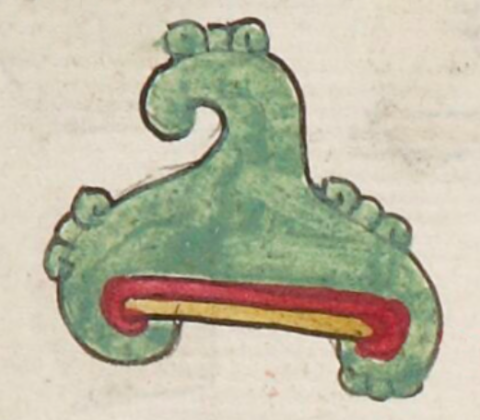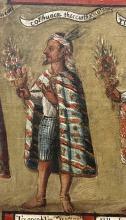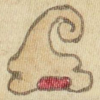Colhuacan (TR29r)
This compound glyph for the place name Colhuacan shows a frontal view of a green mountain with a bend or curve (colli) at the top (but otherwise has a bell shape). The possessive "hua" is not shown visually. The locative suffix is implied by the mountain (tepetl) which does not play a phonetic role in the place name but is a semantic indicator. The mountain or hill is painted in two tones of green. It has curly outcroppings on its slopes, and it has a red and yellow horizontal band at the base. The curve here goes to the viewer's left.
Stephanie Wood
culhuacā
Culhuacan (also spelled Colhuacan)
Stephanie Wood
ca. 1550–1563
Jeff Haskett-Wood
nombres de lugares
This detail comes from a large, eighteenth-century oil painting, El Bautizo de Ixtlilxochitl de Texcoco, previously known as El Bautizo de la nobleza tlaxcalteca and El Bautizo de Cuauhtémoc. The detail features someone with the title Colhuacatecuitli [or Colhuacatecuhtli] Xicotencatl. It is included here as an interesting bit of history (or a memory) of a man from Colhuacan who worked with Xicotencatl of Tlaxcala. Museo Nacional de Historia, Chapultepec Park, Mexico City. Photo by S. Wood, 29 April 2025.

coltic, curved, https://nahuatl.wired-humanities.org/content/coltic
col(li), a bent or twisted thing, https://nahuatl.wired-humanities.org/content/colli-1
-can (locative suffix), https://nahuatl.wired-humanities.org/content/can-2
Telleriano-Remensis Codex, folio 29 recto, MS Mexicain 385, Gallica digital collection, https://gallica.bnf.fr/ark:/12148/btv1b8458267s/f83.item.zoom
The non-commercial reuse of images from the Bibliothèque nationale de France is free as long as the user is in compliance with the legislation in force and provides the citation: “Source gallica.bnf.fr / Bibliothèque nationale de France” or “Source gallica.bnf.fr / BnF.”








